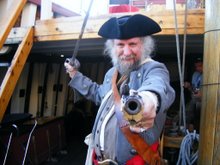A recent episode of Crusoe involved Caruso and Friday finding a damaged boat and a compass. They repaired the boat but Friday seemed reluctant to leave the island. Eventually he admitted that he was worried about slavery, "Slaves in your country don't look like me, they look like you."
The practice of using African slaves in America has given a false impression of slavery in the 17th and 18th century. It was far more universal than just Europeans enslaving Africans. It also has some links with piracy (at least literary piracy).
First, at the same time that Europeans were obtaining slaves from Africa (most often buying Africans who had already been enslaved by fellow Africans), the corsairs of northern Africa were raiding European countries including England for people they could sell as slaves in the Mediterranean. In fact, slavery was not legal in England although it was being introduced to the English colonies about that time. Earlier in the 17th century Africans sold in America were treated as indentured servants but the growing number of free blacks alarmed the colonists and they decided to keep the Africans in permanent bondage.
Now for the literary angle - the last couple of episodes of Crusoe have included flashbacks to a judge during the Monouth Rebellion. This ties in with Rafael Sabatin's Captain Blood. The book starts with Peter Blood, a retired soldier who became a doctor helping a wounded friend. It seems that the friend was part of the Monmouth rebellion and judged a traitor. For helping him, Blood was also convicted of treason. Rather than being executed, they were shipped to the Caribbean and sold as slaves. They eventually escaped and took to piracy until James II was replaced by William and Mary and they were pardoned.
While European enslaving of Africans was not the only slavery going on, it was the most systematic with special ships built to transport slaves. These made excellent pirate ships since they were large, fast, and well-armed. The Whydah was a former slave ship. In another fictional tie-in, Jack Sparrow's Black Pearl was also built to be a slaver.
It is commonly assumed that after pirates captured a slave ship they would free the slaves. This is incorrect. While many pirates were former slaves, pirates seldom had any compunction about treating slaves as plunder and selling them at the closest market.
To really complicate the issue, in the novel, Crusoe was both a slave himself and a slave owner at different points in his life prior to eing shipwrecked.
Subscribe to:
Post Comments (Atom)


No comments:
Post a Comment